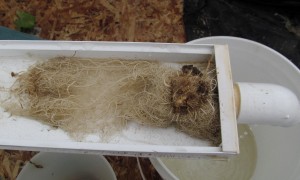In spite of the gorgeous rosette of green leaves adorning each plant are a forgotten, bulky portion of roots. These hardworking organs uptake nutrients, excrete chemicals and provide support for the plant, yet, often go unnoticed to most people. One great aspect of hydroponic growing is noticing every aspect of the plant. For me, it was quite surprising to see thick root masses underneath the eye catching leaves. Lettuce pulled from soil never gives justice to really the density and amount of roots the plant creates for a successful life.
The cleaning begins with each channel’s tube being kinked. This small, two inch piece of plastic is responsible for getting the water from the pipes to the plants. The tube is kinked with an inexpensive clothes line pin. Each channel is pulled out from the main pipe that cycles the nutrient water back into the tank.
After each channel is pulled from the main pipe,the top of the channels are pulled off. The root mass is removed from the channels. Many times, the root masses of multiple plants are intertwined, allowing the entire six foot channel to be rolled into one massive ball. After harvesting eighteen Kale plants, I opened the channels to find a six foot long, two inch thick root mass almost busting out of the channel. Other times, I’ve found each plant’s roots isolated. Each channel and top of the channel is thoroughly scrubbed with warm water and a rag.

A root mass with some stem portion at the end of one channel. This plant’s roots were actually inside the main pipe.
No cleaning chemicals (such as bleach or soap) are added to the water. This is to prevent the possibility of any contamination of the nutrient water. After the channels have been thoroughly scrubbed, the tops are replaced and water is squirted down the channel to remove any roots or plant pieces prior to reconnecting to the main pipe.
The channel is then inserted into the main pipe and the tube is un-kinked. Before the channel is replanted, water is confirmed to be running throughout the channel. It may seem idiotic to emphasize water running in a hydroponic channel, but many times, the tube is merely trickling with barely enough water to feed and hydrate one plant. By determining this before planting, we save time, money and patience.
One issue in hydroponics is attempting to control the growth of the roots. Roots are constantly shed from the plant. Given the flowing of the water, this allows the entire system to be shut down literally by a small portion of the plant. It’s a delicate balance between harvesting as large a plant as possible without allowing the roots to completely fill the channel and beyond. Remember, the more roots a plant has, the more nutrients it needs. Huge root masses can really drain the water tank.
It is important to note that many times, roots are not the only thing in the channels. Algae, leaves and bugs also adorn the inside of the channels. Algae, of course, uses up nutrients in the water and competes with the profitable lettuce. Leaves can clop up the filter, tubes or pipes, devastating rows of plants. While bugs may also clog the system, they devour lettuce and create an unappetizing, “unhealthy” look.
To many people, hydroponics is a monotonous system. Yet, I’ve found passion working with hydroponic lettuce and kale. Harvesting lettuce I planted fills me with more pride than I previously would have thought. Many times, customers have stopped me to learn more about the hydroponic system and are shocked to see the transformation of a two leafed “infant” plant into a robust “adult” beauty.



Speak Your Mind